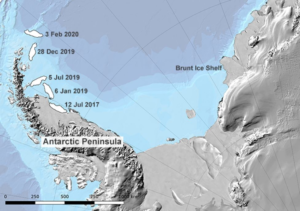In news
the giant iceberg A68 has been drifting from in the Atlantic Ocean, this year due to an ocean current, the iceberg was propelled into the South Atlantic Ocean
About the giant iceberg
- A68 iceberg is the biggest block of free-floating ice from Antarctica with an area of about 5,800 sq. km
- This year, due to an ocean current, the iceberg was propelled into the South Atlantic Ocean and since then it has been drifting towards the remote sub-Antarctic island of South Georgia, prompting fears about the impact the iceberg could have on the island’s abundant wildlife.
What is A68a and where is it headed?
A68a, an iceberg roughly the size of the state of Delaware, split off from Antarctica’s Larsen C ice shelf in July 2017. Since then it has been drifting towards the remote island of South Georgia, which is a British Overseas Territory (BOT).
Movement of the iceberg

What is A68a and where is it headed?
- A68a, an iceberg roughly the size of the state of Delaware, split off from Antarctica’s Larsen C ice shelf in July 2017. Since then it has been drifting towards the remote island of South Georgia, which is a British Overseas Territory (BOT).
- The smaller icebergs have calved from the iceberg on its journey and right now, the biggest section of the iceberg is called A68a and spans an area of roughly 2,600 sq. km
- Recently, the US National Ice Center (USNIC) confirmed that two new icebergs calved from A68a and were large enough to be named and tracked. They are called A68E and A68F.
| Who names icebergs? US National Ice Center (USNIC) is responsible for naming icebergs, which are named according to the Antarctic quadrant in which they are spotted The U.S. National Ice Center (USNIC) is a fully integrated multi-agency organization composed of contributions from the U.S. Navy (USN), the National Oceanic and Atmospheric Administration (NOAA), and the U.S. Coast Guard (USCG). The USNIC monitors the global sea ice environment from its offices at the NOAA Satellite Operations Facility (NSOF) in Suitland, MD. |
The recent calving of the iceberg and climate change
- According to the British Antarctic Survey, the iceberg’s calving is thought to be a natural event and not a result of climate change.
- However, some models predict that a warming Antarctica in the future could mean more calving events as ice shelves and glaciers retreat.
What is the concern?
- The concern is that if the iceberg grounds itself near the island, it could cause disruption to the local wildlife that forages in the ocean.
- According ecologists from the British Antarctic Survey (BAS), which will launch a research mission to study A68a’s impact on the ecosystem next month, if the iceberg gets stuck near the island, it could mean that penguins and seals will have to travel farther in search of food, and for some this might mean that they don’t get back in time to prevent their offspring from starving to death
Positive impact
There are some positives of an iceberg being stuck in the open ocean, since icebergs carry dust which fertilizes ocean plankton, which draws up carbon dioxide from the atmosphere.
















